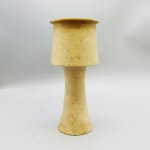Bactrian Chalice , 2250 BC – 1700 BC
Limestone
23.2 x 10 cm
9 1/8 x 4 in
9 1/8 x 4 in
CC.116
Further images
This exceptional stone chalice is the product of the Bactria-Margiana Archaeological Complex (BMAC), also known as the Oxus Civilization, which flourished in Central Asia from 2250 BC to 1700 BC....
This exceptional stone chalice is the product of the Bactria-Margiana Archaeological Complex (BMAC), also known as the Oxus Civilization, which flourished in Central Asia from 2250 BC to 1700 BC. While there are Bactrian sites in the range from Afghanistan to Uzbekistan, most BMAC sites are concentrated around the region known as Margiana in modern Turkmenistan. Excavation from the AD 1970s onwards has revealed that this previously unknown civilisation created numerous monumental structures, fortified by impressive walls and gates, that were quite the match for contemporary civilisations in the Mediterranean and Levant. During the period of the Soviet Union, the discovery of the BMAC was largely unknown to the outside world. However, with the translation of works by the Uzbek archaeologist Viktor Sarianidi in the AD 1990s, the Western world has slowly woken up to the artistic and cultural achievements of the Bactrians.
One of the characteristic outputs of the brief fluorescence of the BMAC was the tall-stemmed stone chalice. The purpose of such chalices is unknown. It is possible that they were some kind of elite tableware, a kind of status-symbol which adorned the feasts of the wealthy. Equally, it has been suggested that they may have had a ritual function, related to the pouring of libations or the sacrifice of liquids. The chalices come in a variety of forms, some short and squat, others tall and elegant. They are also made in a variety of stone, with a clear preference among extant examples for alabaster. This outstanding chalice follows the more elegant classical form: a wide conical foot, leading up to a slender stem, then a broad cylindrical body with a carinated lower edge, crowned with a discoid rim. It is made of a highly polished limestone, which has been smoothed to a velvety finish and shine. The stone is a delicate honey-yellow, with small darker inclusions in the limestone. Tool marks are apparent on the foot. It is in very fine condition, with no restorations, and only minor chips to the rim, carinated edge, and foot. Upon handling, the chalice seems to have a remarkably intense energy.
This chalice, and others like it, would have been carved from a single block of stone: a remarkable feat given the limitations of tools at the time. It would have then been polished with different grades of abrasive stone. The exceptionally high polish would have taken considerable time and effort to achieve. This significant investment demonstrates the importance of this high-status item.
One of the characteristic outputs of the brief fluorescence of the BMAC was the tall-stemmed stone chalice. The purpose of such chalices is unknown. It is possible that they were some kind of elite tableware, a kind of status-symbol which adorned the feasts of the wealthy. Equally, it has been suggested that they may have had a ritual function, related to the pouring of libations or the sacrifice of liquids. The chalices come in a variety of forms, some short and squat, others tall and elegant. They are also made in a variety of stone, with a clear preference among extant examples for alabaster. This outstanding chalice follows the more elegant classical form: a wide conical foot, leading up to a slender stem, then a broad cylindrical body with a carinated lower edge, crowned with a discoid rim. It is made of a highly polished limestone, which has been smoothed to a velvety finish and shine. The stone is a delicate honey-yellow, with small darker inclusions in the limestone. Tool marks are apparent on the foot. It is in very fine condition, with no restorations, and only minor chips to the rim, carinated edge, and foot. Upon handling, the chalice seems to have a remarkably intense energy.
This chalice, and others like it, would have been carved from a single block of stone: a remarkable feat given the limitations of tools at the time. It would have then been polished with different grades of abrasive stone. The exceptionally high polish would have taken considerable time and effort to achieve. This significant investment demonstrates the importance of this high-status item.













